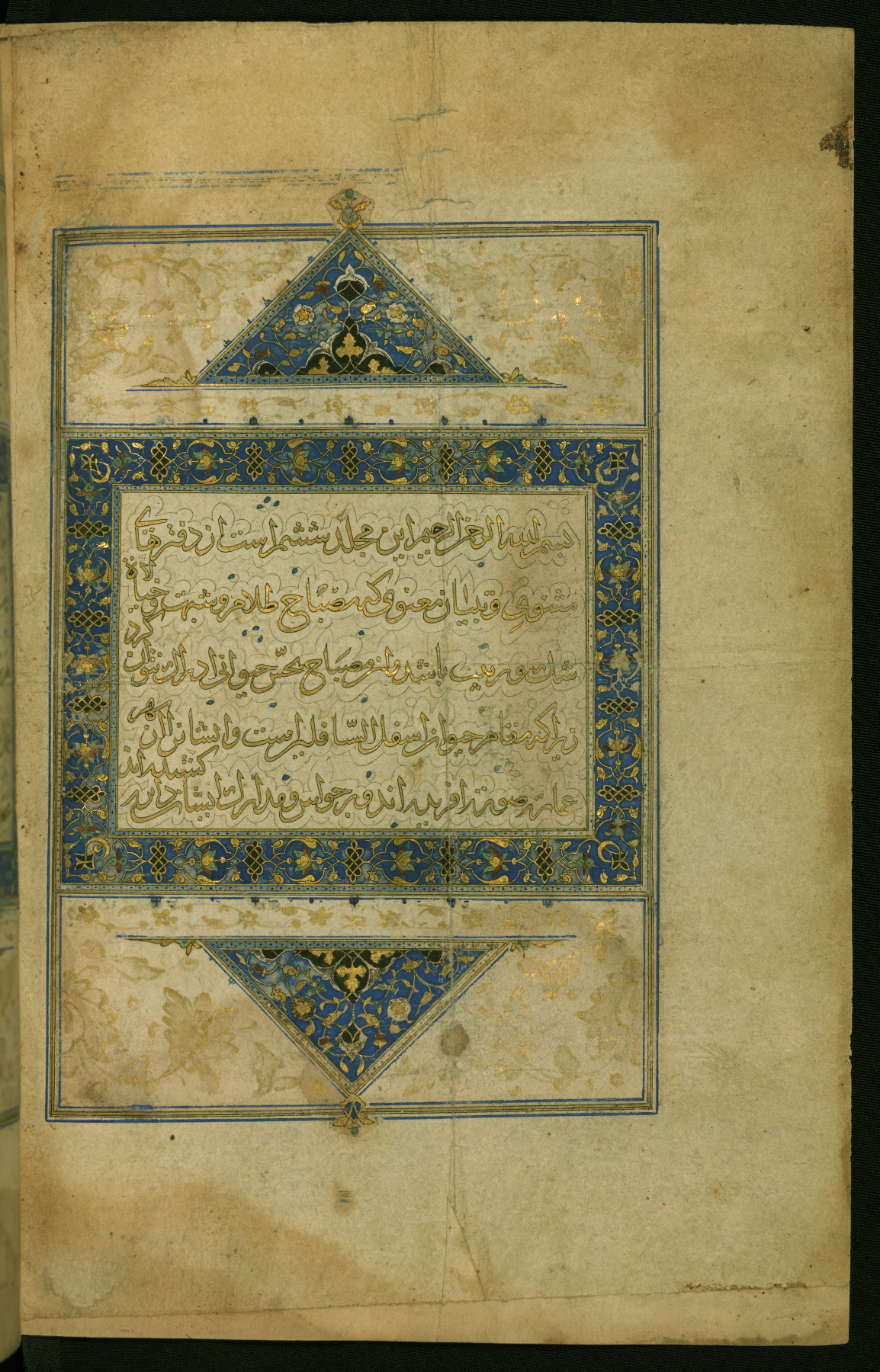Baltimore, The Walters Art Museum
 Prologue of the first book (fol. 1b)
Prologue of the first book (fol. 1b)
 Prologue of the second book (fol. 51b)
Prologue of the second book (fol. 51b)
 Third book (fol. 96b)
Third book (fol. 96b)
 Prologue of the fourth book (fol. 155b)
Prologue of the fourth book (fol. 155b)
 Prologue of the sixth book (fol. 256b)
Prologue of the sixth book (fol. 256b)
1461 • This is an illuminated copy of the collection of poems known as مثنوى معنوى (Mas̱navī-i maʿnavī) by Jalāl al-Dīn Rūmī (d. 672 AH / 1273 CE), likely produced in Timurid Iran. The Mas̱navī-i maʿnavī, which is a didactic poetical work divided into six books or booklets (daftars), is of particular importance in the tradition of Sufism. According to the colophon, written in Arabic, this copy was completed in 865 AH / 1461 CE by Aḥmad ibn Ḥājjī Abī Bakr al-Kātib (fol. 311a). Each of the six books is introduced by a preface in Arabic or Persian, executed largely in gold tawqīʿ script (fols. 1b-2a, 51b-52a, 95b-96a, 155b-156a, 203b-204a, and 256b-257a). The text proper is written in black nastaʿlīq script, with illuminated titlepieces inscribed in a decorated New Abbasid (broken cursive) style (fols. 2b, 52b, 96b, 156b, 204b, and 257b). The dark red leather binding is not original to the manuscript and dates to the thirteenth century AH / nineteenth CE.
 A woman plays a rudhra veena in the company of tamed animals and birds (fol. 170A)
A woman plays a rudhra veena in the company of tamed animals and birds (fol. 170A)
IV, 475-486 (translation by Reynold A. Nicholson):
Because Paradise has not been fashioned out of (the builder’s) materials; nay, but it has been fashioned out of (good) deeds and intentions.
This edifice has been (made) of dead water and earth, while that edifice has arisen from living piety.
This (edifice) resembles its foundation (which is) full of defect, and that (edifice resembles) its foundation, which is knowledge and action.
Both throne and palace and crown and robes are (engaged) in question and reply (conversation) with the inhabitant of Paradise.
The carpet (there) is folded without the farrash (carpet-spreader); the house (Paradise) is swept without the broom.
Behold the house of the heart: it was disordered by (worldly) cares: without sweeper it was swept (clean) by a (vow of) repentance.
Its throne moved along without carrier; its door-ring and door became (sweet-sounding like) musician and singer.
The life of the everlasting Abode (Paradise) exists in the heart: since it comes not on to my tongue, what is the use (of my attempting to describe it)?
When Solomon went into the Mosque every morning to guide the servants (of God) in the right way,
He would give exhortation, sometimes by speech and melody and harmony, sometimes by act—I mean, a bowing or (service of) prayer.
The exhortation of act draws people more powerfully, for it reaches the soul of every one that hath hearing and (also) the deaf.
In that (kind of exhortation) the conceit of princedom is less (than in the other kind): the impression made by it upon the (prince’s) followers is strong.
1663 • Jelal ad-Din Rumi's mystic main opus مثنوى معنوى (Mas̱navī-i maʿnavī "The Spiritual Couplets") in Persian double verses (masnavi) with Indian illustrations. According to the colophon (fol. 314b), the text, written in black nastaʿlīq script, was completed in India in 1073 AH / 1663 CE. Each section of the work is introduced by a double-page illuminated incipit containing a preface in prose, followed by two illustrations and an illuminated incipit page for the masnavi. In total, fifty paintings illustrate the text. The green leather binding is modern.





Replies